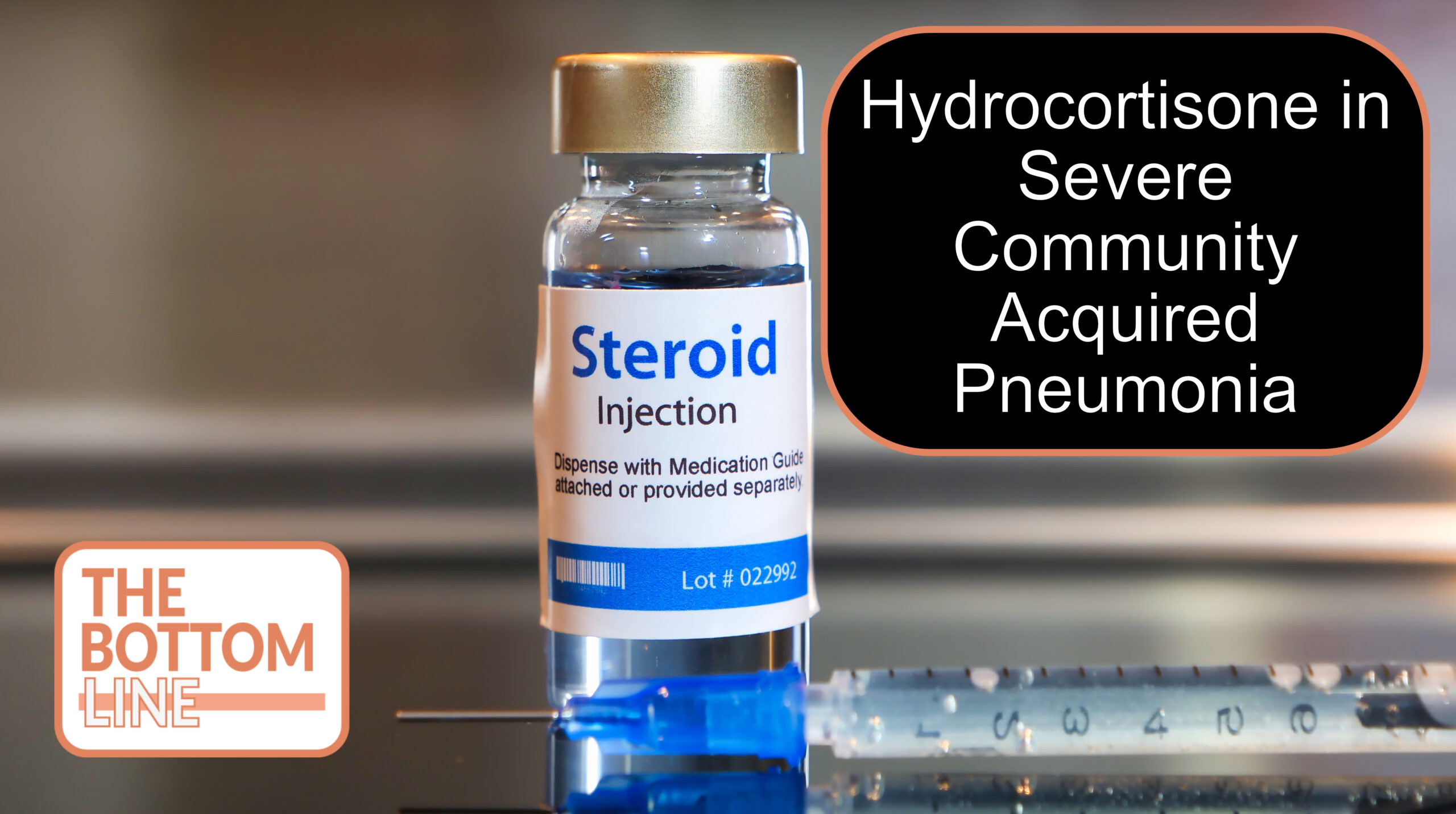CAPE COD

Hydrocortisone in Severe Community Acquired Pneumonia
P.F. Dequin et al. NEJM. 2023 DOI:10.1056/NEJMoa2215145
Clinical Question
- In patients with severe community acquired pneumonia (CAP) does the use of hydrocortisone compared to a placebo reduce 28-day mortality?
Background
- Severe CAP has significant associated morbidity and mortality with up to 10% of those admitted to hospital requiring ICU admission
- The use of steroids in CAP has been contentious with differing recommendations in various society guidelines
- The ATS / ISDA recommend against their use in severe CAP, however the ESICM / SCCM guidelines favour their use
- The recently published trial by Meduri et al showed no 60-day mortality benefit with the use of methylprednisolone in severe CAP. However, the conclusion in the associated editorial calls for further large scale RCTs before strong recommendations are made with respect to this intervention
Design
- Double blind, placebo controlled, multi-centre RCT
- Centralised randomisation using a web-based system
- 1:1 ratio in block sizes of 4
- Stratified according to trial site and the use of mechanical ventilation
- Placebo identically packaged
- Power calculation
- 1146 patients needed to provide 80% power to detect a 25% relative risk reduction in mortality from a baseline of 27%
- COVID-19 meant that recruitment was paused after 800 randomised as the trial group focused on a separate trial evaluating the use of hydrocortisone in COVID-19
- DSMB recommended discontinuation of enrolment at planned second interim analysis
- This was based on: (1) felt to be unethical to continue to include placebo group, (2) the prolonged suspension and (3) another 400 patients unlikely to change outcome
Setting
- 31 French centres
- October 2015 to March 2020
Population
- Inclusion:
- Age > 18
- Admission to ICU
- CAP diagnosis suggested by ≥ 2 of cough, purulent sputum, chest pain and dyspnoea
- Focal shadowing on CXR / CT scan
- Severe disease defined by at least 1 of the following:
- Pulmonary severity index (PSI) score > 130
- Mechanical ventilation
- HFNC with FiO2 > 0.5 and P/F ratio < 300
- Rebreathing mask with P/F ratio dependent on O2 flow (e.g. >10L the P/F < 300)
- At least one dose of antibiotics administered
- Exclusion:
- Treated by vasopressors for septic shock at time of inclusion
- Clinical history suggesting aspiration
- Treated by invasive mechanical ventilation within last 14 days
- > 7 days of antibiotics prior
- PCR +ve for influenza
- Use of > 15mg prednisolone (or equivalent) / day for > 30 days
- Pregnancy
- CF, active TB or fungal infection and active viral hepatitis or active infection with herpes virus
- 5948 screened with 800 randomised
- 401 to receive hydrocortisone
- 399 to receive placebo
- Comparing baseline characteristics of intervention vs. control group
- Balanced between groups
- Age: 67 vs 67
- Male: 70 vs 69%
- COPD: 22 vs 27%
- Diabetes: 24 vs 22%
- Mechanical Ventilation (IMV or NIV): 45 vs 44%
- HFNC: 42 vs 41%
- Nonrebreather mask: 13 vs 15%
- PSI Score IV: 38 vs 34%
- PSI Score V: 46 vs 49%
- Median CRP: 26 vs 24 mg/dL
- Median Cortisol: 302 vs 307 nmol/L
Intervention
- Hydrocortisone
- 200mg/day for 4 days
- Treating team using predefined criteria decided whether to administer for a total of 8 or 14 days with a prespecified tapering plan
- 8 days total if all of the following met on day 4: P/F > 200, breathing spontaneously and day 4 SOFA ≤ the SOFA score on day 1
- Median duration 5 days
Control
- Placebo
- Same protocol used
- Median duration 6 days
Management common to both groups
- Treatment discontinued on ICU discharge
- Other management (including choice of respiratory support) at discretion of treating teams but should follow standard therapy
Outcome
- Primary outcome:
- Death by day 28: Hydrocortisone 6.2% vs Placebo 11.9%
- Difference -5.6% (-9.6 to -1.7%), p = 0.006
- Death by day 28: Hydrocortisone 6.2% vs Placebo 11.9%
- Secondary outcomes:
- Comparing hydrocortisone vs. placebo group
- No significant difference in
- Cumulative incidence of hospital acquired infection by day 28: 9.8 vs 11.1%
- Cumulative incidence of GI bleeding by day 28: 2.2 vs 3.3%
- Significantly greater in intervention group
- Median daily dose of insulin by day 7: 35.5 vs 20.0 IU/day
- Significantly less in intervention group
- Death by day 90: 9.3% vs 14.7%
- Cumulative incidence of endotracheal intubation by day 28: 18.0 vs 29.5%
- Cumulative incidence of endotracheal intubation by day 28 in those not receiving at baseline: 19.5% vs 27.7%
- Cumulative incidence of vasopressor initiation by day 28 in those not receiving at baseline: 15.3 vs 25.0%
- No significant difference in
- Selected Subgroups:
- Comparing hydrocortisone vs placebo, the following subgroups trended to favouring hydrocortisone use:
- Not mechanically ventilated: 6/222 vs 22/220
- Risk difference -7.3 (95% CI -12.6 to -2.0)
- No germ isolated: 11/189 vs 25/168
- Risk difference – 9.1 (95% CI -15.0 to -3.1)
- Age > 65: 19/222 vs 38/228
- Risk difference -8.1 (95% CI -13.3 to -2.9)
- Women: 4/119 vs 16/124
- Risk difference -9.5 (95% CI -16.7 to -2.3)
- Not mechanically ventilated: 6/222 vs 22/220
Authors’ Conclusions
- Early treatment with hydrocortisone reduced 28-day mortality in those admitted to the ICU with severe CAP
Strengths
- Multi-centre, double blind, placebo-controlled trial
- Balanced baseline characteristics – especially with respect to other classically steroid responsive conditions such as COPD and asthma
- Early initiation of hydrocortisone – initiated within ~20 hours from hospital admission
- Minimal apparent selection bias – of the 5148 excluded, very few were for reasons other than the pre-defined exclusion criteria (n = 276 “medical team declined” and n = 79 “no reason provided”)
- Minimal loss to follow up (2 patients)
- The exclusion of septic shock sensible given potential benefits shown with the use of steroids in this patient cohort
- Included patients who clearly had severe CAP with respect to ventilatory support required at randomisation and PSI score
- High level of adherence to protocol with very few protocol violations
- Only 6% received open label steroids
Weaknesses
- Single country
- Although 800 patients randomised there were lower mortality numbers than predicted
- Only 72 deaths across both arms with a fragility index 6 patients
- Optimal steroid and steroid regimen (e.g. tapered or not) yet to be determined especially with differing pharmacological properties
- The benefit of dexamethasone shown in COVID-19 in the RECOVERY trial and ARDS patients in DEXA-ARDS trial
- Microbiological investigation not standardized
- ~45% no pathogen identified
- The subgroup in which no pathogens were isolated trended to favouring steroid use compared to those in whom a pathogen was isolated (Figure S3)
The Bottom Line
- Following this trial, I will now strongly consider the use of steroids in patients admitted with severe CAP
- I await the publication of REMAP-CAP non pandemic corticosteroid domain, as a larger platform trial will hopefully further inform practice
External Links
Metadata
Summary author: George Walker
Summary date: 21st March 2023
Peer-review editor: David Slessor
Picture by: iStock



